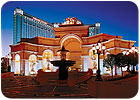
Cooled by five 1,000-ton chillers that operate on 4,160V, the Monte Carlo Resort & Casino expects savings from its medium-voltage VSDs. System performance is paramount in an atmosphere where even a 1° change in temperature can start to cause discomfort among guests, who may in turn move to another casino.
When the Monte Carlo Resort & Casino opened on the Las Vegas Strip in 1996, the 2.5-million-sq-ft hotel and casino incurred annual energy costs of approximately $0.05/kWh used. Ten years later, these expenses had doubled to $0.10/kWh utilized, and Nevada Power Company recently announced a proposed utility rate increase request of 23.3%.
Owned by MGM Mirage, the resort includes 3,002 rooms and 259 suites. The 90,000-sq-ft gaming area offers a broad range of games; 2,200 slots and video-poker machines; and sports-betting areas. The resort also features eateries, a brewpub, convention facilities, a wedding chapel, theater, spa, fitness center, shopping promenade, pool area, and tennis courts.
CRITICAL CUSTOMER COMFORT
Temperature control throughout the resort is not only important to customer comfort for overnight guests but also to the casino business. It only takes a 1°F change in space temperature to cause discomfort among guests, who may move to another casino.Since the resort opened, an on-site central plant has provided comfort cooling for the estimated 10,000 people who occupy the facility at any given time. Operating on medium voltage (4,160V), the central plant includes five 1,000-ton, R-134A, constant-speed centrifugal chillers, manufactured by YORK (a Johnson Controls Company); five cooling towers; and two heat exchangers. The plant operates in an environment where the outdoor ambient temperature ranges from a low of 30° in the winter to a high of 115° in the summer. In addition to temperature extremes, increasing humidity places additional demands on the chillers.
Since the HVAC system at Monte Carlo is responsible for approximately 60% of the resort's energy costs, it became the focus of energy-saving opportunities. According to Gary Hughes, director of engineering for Monte Carlo Resort & Casino, the resort's engineering department began making changes to the HVAC system three years ago.
The first step involved monitoring the building temperature more closely. Next, the engineering department added variable orifices to the five YORK MAXE™ chillers, saving energy by allowing the tower water entering the chillers to run as low as 55°.
Expanding the size of the cooling towers also improved plant efficiency by increasing the capacity of each chiller from 1,000 to 1,050 tons at peak design conditions. And according to Hughes, it enabled the facility to run three chillers and three towers under conditions that previously demanded the operation of four chillers and five towers. The larger towers also increased opportunities for free cooling, utilizing the plate-and-frame heat exchangers as waterside economizers during cooler months.
A NEW TYPE OF VSD
In a third step taken just this year, the resort became the first building in the world to install medium-voltage VSDs offered by a chiller manufacturer: YORK OptiSpeed™ drives. Previously, low-voltage VSDs for chillers were available for facilities using medium voltage, but required an additional step-down voltage transformer. Existing 4,160V chillers also required the additional expense of a low-voltage motor.The system also employs a YORK OptiView™ Control Center that gives Hughes with much appreciated access to trending graphs and historical reports, simplifies chiller operating decisions, and guides him in troubleshooting. "The OptiView feature provides us with a wealth of valuable information, right down to the dollars we are saving at any given time by using OptiSpeed drives," he said.
The drives' footprints also worked to the advantage of the resort. The three drives fit in the space occupied by three of the original electro-mechanical starters, under and behind an AHU. The drives' modular design was also beneficial, because the cabinet could be broken down into sections and then bolted together.
